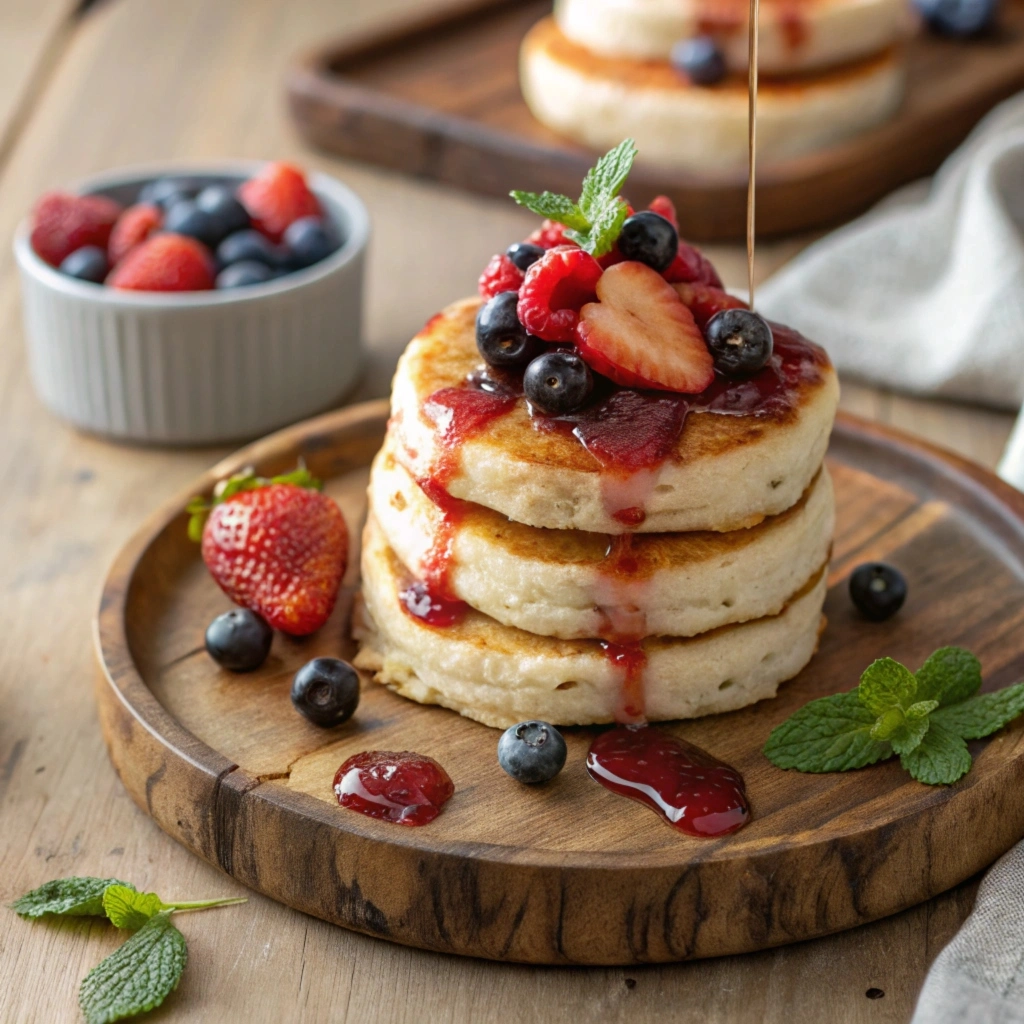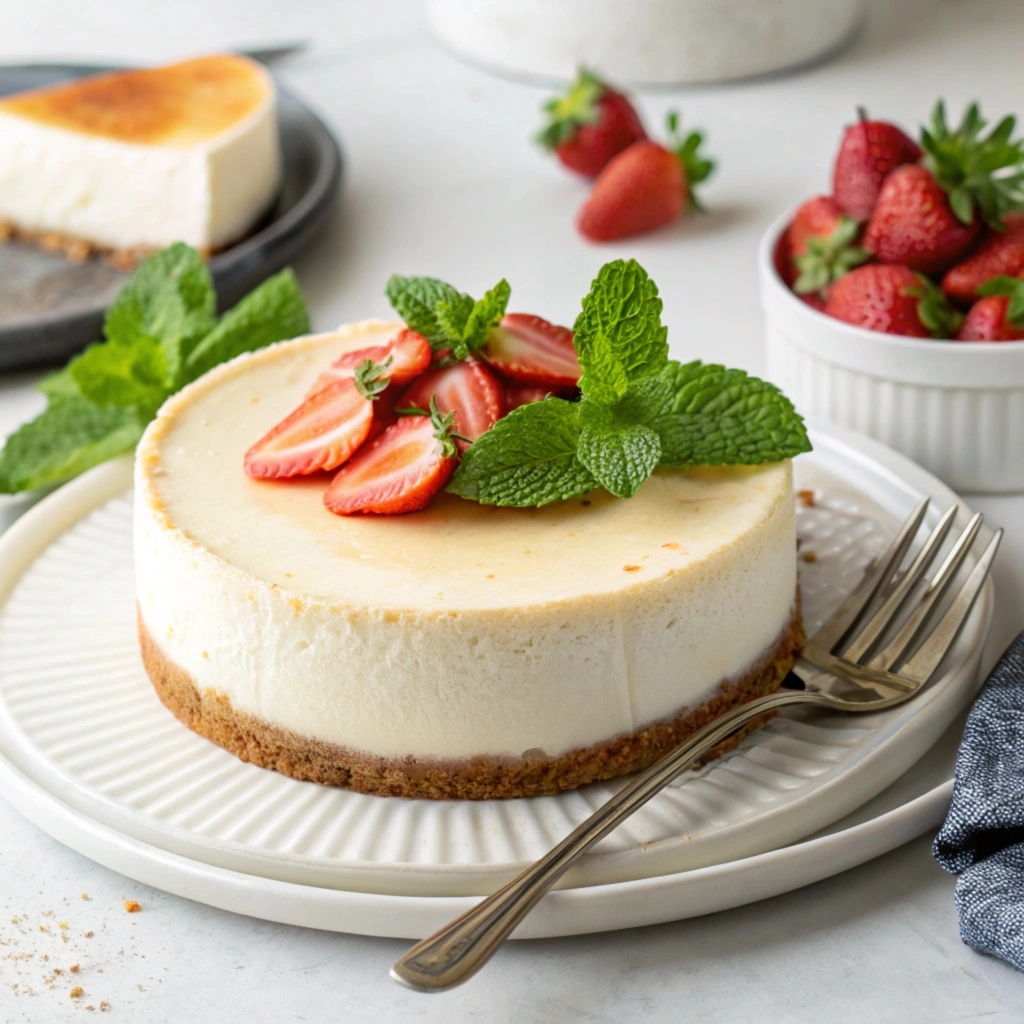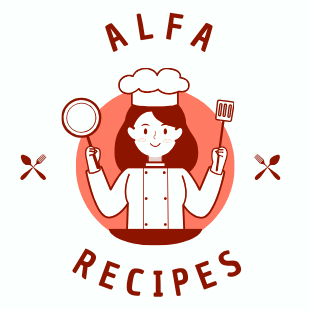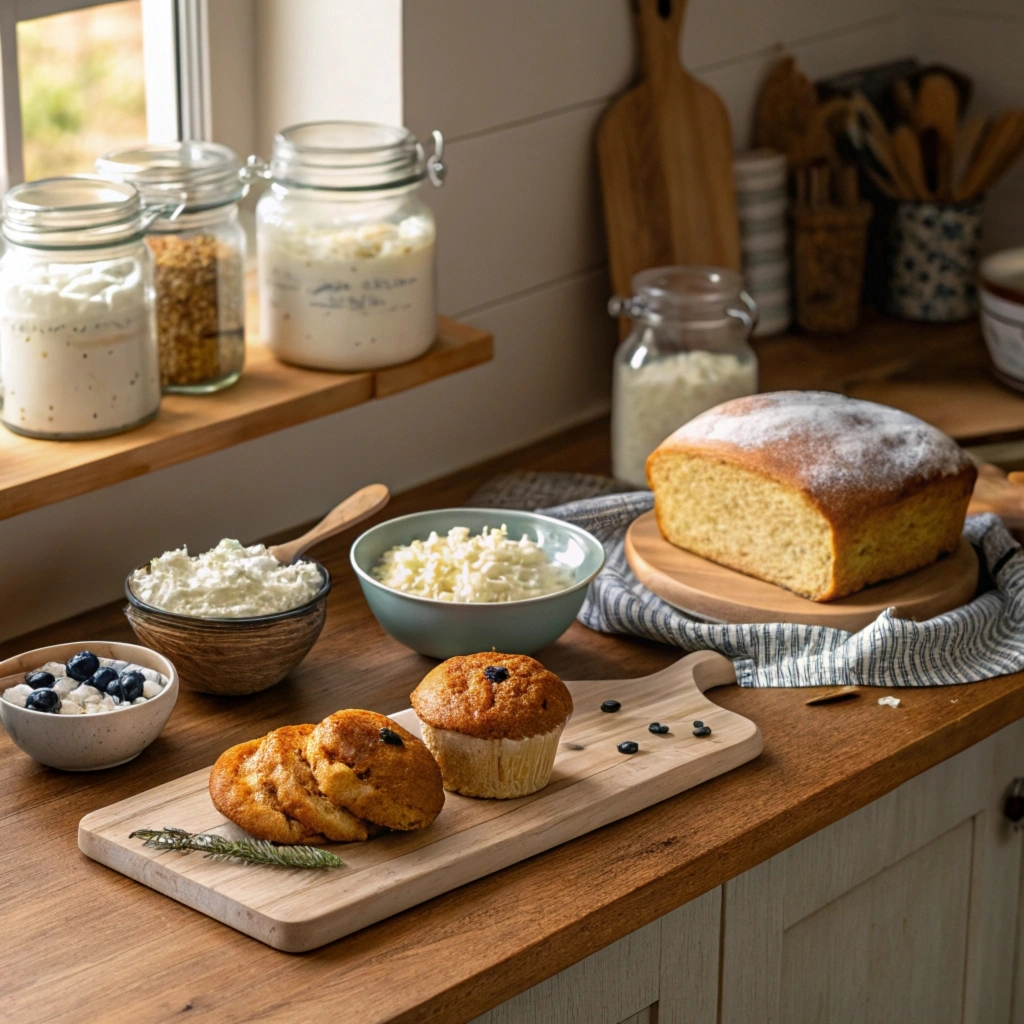Baking is an art, but it’s also a science. Every ingredient matters, right? If you’ve ever stood in your kitchen, eyeing that tub of cottage cheese and wondering, “Could this actually work in my next baking experiment?”, you’re not alone. Whether you’re a seasoned baker or just dabbling, cottage cheese might be the secret ingredient you didn’t know you needed.
In this article, we’ll dive deep into why cottage cheese can be a game-changer in baking, what makes it tick, and how to use it to create delectable treats. Let’s get started! 😊
Introduction
The Rising Popularity of Cottage Cheese in Baking
Cottage cheese in baking? It’s not as strange as it sounds. Over the past few years, people have been swapping out traditional ingredients like butter, cream cheese, and yogurt for cottage cheese in their recipes. Why? Because it’s versatile, nutrient-packed, and surprisingly delicious when baked. Plus, as more people look for ways to lighten up their favorite dishes, cottage cheese is proving to be a healthier alternative.
Why This Article Matters for Bakers
If you’re hesitant about introducing cottage cheese to your recipes, this article is here to answer all your questions. We’ll break down its benefits, tackle common concerns, and share practical tips to help you master the art of baking with this underrated ingredient. Stick around—it’s going to be worth it!
What Is Cottage Cheese?
Understanding the Basics of Cottage Cheese
Cottage cheese is essentially curdled milk that’s been drained but not pressed. This leaves you with those signature curds floating in a bit of whey. It has a mild flavor that’s neither overpowering nor bland, making it a great addition to both sweet and savory dishes. Depending on your preferences, you can choose from full-fat, low-fat, or fat-free options.
Now, you might be thinking, “Curds in my cake? Really?” But hear me out—when blended or mixed, cottage cheese creates a creamy, smooth texture that works beautifully in batters.
Nutritional Profile of Cottage Cheese
One of the biggest perks of cottage cheese is its nutritional value. Here’s a quick snapshot:
- Protein powerhouse: Packed with casein protein, cottage cheese is great for building and repairing tissues.
- Low in fat and calories: It’s a lighter choice compared to butter, cream, or even ricotta.
- Rich in calcium: Helps strengthen bones and teeth—an added bonus if you’re baking for kids or family.
- Versatile nutrient base: Cottage cheese is also a good source of B vitamins, phosphorus, and selenium.
Here’s a fun fact for you: 100 grams of cottage cheese can have up to 11 grams of protein! That’s why fitness enthusiasts often rave about it. Who knew your cheesecake could pack a protein punch? 🧀💪
Benefits of Using Cottage Cheese in Baking
Adds Moisture and Creaminess to Baked Goods
Think about those times when your baked goods turned out dry or crumbly. Frustrating, right? Cottage cheese can save the day. Its natural moisture content makes cakes, muffins, and breads irresistibly moist and tender. Plus, the mild tang of cottage cheese adds depth without overpowering the other flavors.
“Moisture is the soul of a good bake. Cottage cheese? It’s the secret ingredient that locks it in!”
A Healthy Alternative to Traditional Baking Ingredients
Trying to cut back on calories or fat? Cottage cheese is your best friend. It can replace high-fat ingredients like cream or butter without compromising the taste or texture. For instance, you can use blended cottage cheese instead of cream cheese in cheesecakes or as a partial substitute for butter in cookies. The result? Guilt-free indulgence. 🍰✨
Enhances Texture and Flavor in Recipes
One of the lesser-known benefits of cottage cheese is its ability to improve texture. Whether it’s adding a subtle creaminess to a cheesecake or lending a fluffy, airy quality to pancakes, cottage cheese makes everything feel (and taste) better. Plus, its mild tang can enhance both sweet and savory profiles—imagine a savory muffin with herbs and cottage cheese. Yum!
Common Concerns About Baking with Cottage Cheese
Will Cottage Cheese Affect the Taste?
This is the first question most people ask, and the answer is reassuring: not really! Cottage cheese has a subtle flavor that easily blends into other ingredients. When baked, its tanginess mellows out, leaving behind a rich, creamy taste that complements both sweet and savory recipes.
Does It Work Well with Sweet and Savory Dishes?
Absolutely! Cottage cheese is a chameleon in the kitchen. For sweet dishes, blend it to create a smooth base for cheesecakes, pancakes, or muffins. For savory options, its natural tang pairs beautifully with spices, herbs, and cheeses.
Best Types of Cottage Cheese for Baking
Choosing the Right Fat Content
When selecting cottage cheese for baking, fat content matters. Full-fat varieties are ideal for rich, creamy results (think cheesecakes or bread). However, if you’re aiming for healthier bakes, low-fat or fat-free options work just as well.
H3: Small Curd vs. Large Curd Cottage Cheese
Another factor to consider is curd size. Small curd cottage cheese blends more easily, creating a smoother texture in your batters. Large curds, on the other hand, may require extra blending but can add a unique texture to some recipes, like savory muffins.
How to Use Cottage Cheese in Baking
Substituting Cottage Cheese for Other Ingredients
So, how exactly do you incorporate cottage cheese into your recipes? The trick lies in substitution. Cottage cheese can replace several traditional baking ingredients without compromising the texture or taste. Here are a few common swaps:
- Cream cheese: Blend cottage cheese until smooth, and you’ve got a lower-fat alternative for cheesecakes and frostings.
- Butter or oil: Replace half the butter or oil in recipes like muffins or cakes with blended cottage cheese to cut calories while maintaining moistness.
- Milk or cream: For recipes that call for cream, try using cottage cheese for a thicker consistency and extra protein.
Does this mean you’ll have to experiment a bit? Sure. But once you get the hang of it, you’ll wonder why you didn’t try it sooner.
Blending Techniques for a Smooth Texture
The key to using cottage cheese effectively in baking is blending. Since it has curds, you’ll want to break them down for a smoother texture. A blender or food processor works wonders here. Simply toss in your cottage cheese and blend until it’s creamy and lump-free. This step is especially important for sweet recipes like cheesecakes, where a smooth texture is non-negotiable.
Pro Tip: “If you’re working with a handheld mixer, blend the cottage cheese first separately before incorporating it into the batter. Smooth batter, smooth results!”
Popular Recipes Using Cottage Cheese
Cottage Cheese Pancakes

Who doesn’t love a stack of fluffy pancakes? Cottage cheese pancakes are not only light and airy but also packed with protein. Blend cottage cheese with eggs, flour, and a pinch of sugar, and you’ve got a breakfast that tastes indulgent but feels guilt-free. Top it with fresh fruits or a drizzle of honey for that extra oomph.
Cheesecake with Cottage Cheese

This is a game-changer for cheesecake lovers. By substituting cream cheese with blended cottage cheese, you cut down on calories while keeping the creamy texture intact. The tanginess of cottage cheese adds a unique depth of flavor that’ll make your cheesecake stand out.
Savory Cottage Cheese Muffins

If you’re into savory bakes, these muffins are a must-try. Mix cottage cheese with spinach, herbs, and a sprinkle of Parmesan for a deliciously moist snack. Perfect for breakfast or a quick bite on the go.
Cottage Cheese Bread
Yes, you read that right—bread! Cottage cheese can be used to make a soft, fluffy loaf that pairs beautifully with soups, stews, or just a slab of butter. It adds moisture and a subtle tang that elevates the flavor.
Troubleshooting Common Problems
Cottage Cheese Too Watery: How to Fix It
One common issue bakers face with cottage cheese is its high water content. Too much liquid can mess up the consistency of your batter. The solution? Drain it! Use a fine mesh strainer or cheesecloth to remove excess moisture before blending it into your recipe.
Cottage Cheese Clumps: Blending Tips
No one likes clumps in their batter. If your cottage cheese refuses to blend smoothly, add a splash of milk or cream while blending. This will help break down the curds and achieve a velvety consistency.
Quote Block: “Smooth batter is happy batter. Take your time to blend cottage cheese properly—it makes all the difference!”
Expert Tips for Baking with Cottage Cheese
Enhancing Flavors with Spices and Herbs
Want to take your savory bakes to the next level? Pair cottage cheese with bold flavors like garlic, dill, or smoked paprika. These spices complement the tangy profile of cottage cheese, creating bakes that are anything but boring.
Storage and Preparation Guidelines
When working with cottage cheese, freshness is key. Always use cottage cheese that’s well within its expiration date to avoid any funky flavors. Store it in the refrigerator and take it out about 15 minutes before using to avoid shocking your batter with cold ingredients.
Comparing Cottage Cheese with Other Dairy Options
Cottage Cheese vs. Cream Cheese
When it comes to baking, cream cheese is the go-to ingredient for creamy and rich recipes like cheesecakes and frostings. But how does cottage cheese stack up?
- Texture: Cream cheese is naturally smooth, while cottage cheese requires blending to achieve the same texture.
- Calories and Fat: Cottage cheese is significantly lower in calories and fat, making it a healthier option for lighter desserts.
- Flavor: While cream cheese has a rich and tangy flavor, cottage cheese offers a milder tang. This makes it versatile for both sweet and savory recipes.
If you’re aiming for a healthier twist on a classic recipe, cottage cheese is an excellent substitute for cream cheese.
Cottage Cheese vs. Ricotta
At first glance, cottage cheese and ricotta may seem interchangeable. They’re both soft, fresh cheeses, but they have distinct characteristics:
- Moisture Content: Cottage cheese has higher water content than ricotta, which may require draining in certain recipes.
- Texture: Ricotta is smoother and creamier right out of the container, while cottage cheese has distinct curds.
- Nutritional Value: Cottage cheese wins in terms of protein content, while ricotta has slightly more fat.
For recipes like lasagna or stuffed pasta, either cheese works. But in baking, cottage cheese may need blending to achieve the smoothness of ricotta.
Frequently Asked Questions About Cottage Cheese in Baking
Can Cottage Cheese Be Used in Gluten-Free Recipes?
Absolutely! Cottage cheese is naturally gluten-free, making it a great ingredient for gluten-free baking. You can use it in gluten-free pancakes, muffins, or even bread. Its protein content can also improve the texture of gluten-free baked goods, which often suffer from being too crumbly.
Is Cottage Cheese Suitable for Low-Carb Baking?
Yes, and it’s a fantastic option for those following a low-carb or keto diet. With minimal carbs and high protein, cottage cheese can be used to create low-carb cheesecakes, breads, or muffins. Just pair it with low-carb flours like almond or coconut flour for the perfect bake.
Conclusion
Key Takeaways on Using Cottage Cheese in Baking
So, is cottage cheese good for baking? The answer is a resounding yes! It’s versatile, healthy, and capable of transforming your baked goods in delightful ways. From adding moisture to enhancing textures, it’s a game-changer for anyone looking to experiment in the kitchen.
Encouragement to Experiment with Cottage Cheese in Recipes
If you’ve never baked with cottage cheese before, now’s the time to give it a shot. Start small—maybe with pancakes or muffins—and work your way up to more adventurous recipes like cheesecakes or breads. Baking is all about creativity and fun, so don’t be afraid to try something new. Who knows? Cottage cheese might just become your favorite secret ingredient. 🧁✨
Quote Block: “Baking is all about experimenting. Cottage cheese opens up a world of possibilities—why not explore it?”

